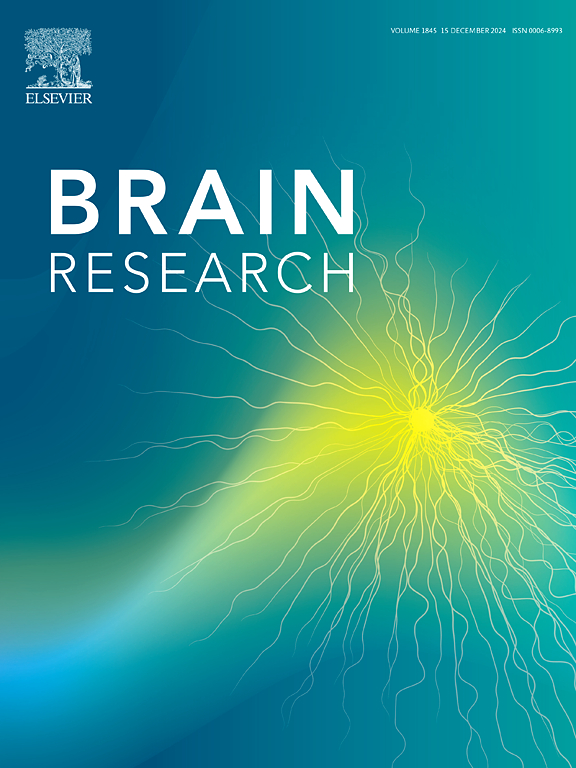动脉粥样硬化中被破坏的结构网络弹性:一项大规模队列研究
IF 2.7
4区 医学
Q3 NEUROSCIENCES
引用次数: 0
摘要
动脉粥样硬化是老年人认知能力下降的一个主要因素,通常与白质高强度的积累有关。大脑的恢复力,即大脑承受外部干扰的能力,在动脉粥样硬化如何影响它,进而影响认知方面仍然知之甚少。在这里,我们研究了动脉粥样硬化、白质高强度和结构网络弹性之间的关系,以及它们对认知表现的综合影响。方法:我们利用来自大规模社区队列多血管评估的认知障碍和血管事件的数据(n = 2160)。构建全脑结构连接,并基于白质高强度模拟结构断开。信噪比作为量化结构网络弹性的标志,由原始网络与断开的对应网络之间的枢纽节点的相似性定义。结果与动脉状态相关的白质高信号相比,信噪比更高。此外,链式中介分析表明,与动脉粥样硬化相关的认知能力下降部分由白质高强度和结构网络弹性介导。随着年龄的增长,动脉粥样硬化加速了大脑结构网络弹性的退化。这些发现表明,信噪比可以为动脉粥样硬化引起的认知能力下降提供补充见解,并可作为动脉粥样硬化条件下大脑健康的潜在生物标志物。此外,信噪比可以作为指导未来动脉粥样硬化治疗选择的指标。本文章由计算机程序翻译,如有差异,请以英文原文为准。

Disrupted structural network resilience in atherosclerosis: A large-scale cohort study
Background
Atherosclerosis is a major factor in cognitive decline among aging individuals and is frequently linked to the accumulation of white matter hyperintensities. Brain resilience, which represents the brain’s capacity to withstand external disruptions, remains poorly understood in terms of how atherosclerosis impacts it and, in turn, influences cognition. Here, we investigated the relationship between atherosclerosis, white matter hyperintensities, and structural network resilience, along with their combined effects on cognitive performance.
Methods
We utilized data from the large-scale community cohort Polyvascular Evaluation for Cognitive Impairment and Vascular Events (n = 2160). Whole-brain structural connections were constructed, and structural disconnections were simulated based on white matter hyperintensities. SNR, serving as a marker to quantify structural network resilience, is defined by the similarity of hub nodes between the original network and its disconnected counterpart.
Results
SNR showed higher odds ratios compared to white matter hyperintensities in relation to arterial status. Additionally, chain mediation analysis indicated that cognitive decline associated with atherosclerosis was partially mediated by both white matter hyperintensities and structural network resilience. Atherosclerosis accelerates the degradation of brain structural network resilience as age increases.
Conclusions
These findings suggest that SNR could offer complementary insights into cognitive decline caused by atherosclerosis and serve as a potential biomarker of brain health in atherosclerotic conditions. Additionally, SNR may act as an indicator for guiding the selection of future therapies for atherosclerosis.
求助全文
通过发布文献求助,成功后即可免费获取论文全文。
去求助
来源期刊

Brain Research
医学-神经科学
CiteScore
5.90
自引率
3.40%
发文量
268
审稿时长
47 days
期刊介绍:
An international multidisciplinary journal devoted to fundamental research in the brain sciences.
Brain Research publishes papers reporting interdisciplinary investigations of nervous system structure and function that are of general interest to the international community of neuroscientists. As is evident from the journals name, its scope is broad, ranging from cellular and molecular studies through systems neuroscience, cognition and disease. Invited reviews are also published; suggestions for and inquiries about potential reviews are welcomed.
With the appearance of the final issue of the 2011 subscription, Vol. 67/1-2 (24 June 2011), Brain Research Reviews has ceased publication as a distinct journal separate from Brain Research. Review articles accepted for Brain Research are now published in that journal.
 求助内容:
求助内容: 应助结果提醒方式:
应助结果提醒方式:


